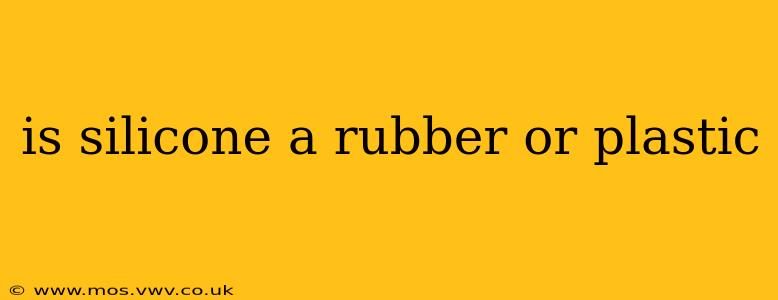Is Silicone a Rubber or a Plastic? Understanding the Material's Unique Properties
Silicone is a fascinating material often causing confusion because it shares characteristics with both rubber and plastic. However, it's neither strictly a rubber nor a plastic in the traditional sense. Instead, it occupies a unique space in the world of polymers. This article will delve into the properties of silicone and clarify its relationship to rubber and plastic.
What is Silicone?
Silicone, also known as polysiloxane, is a synthetic polymer made up of a silicon-oxygen backbone chain (–Si–O–Si–O–). These chains are often modified with various organic groups, which significantly impact the material's properties. This unique structure is what sets silicone apart from traditional rubbers and plastics.
Silicone vs. Rubber: Key Differences
While silicone exhibits some rubber-like properties such as flexibility and elasticity, crucial differences exist:
-
Chemical Structure: Rubbers, like natural rubber (latex) or synthetic rubbers (e.g., neoprene, styrene-butadiene), are primarily composed of carbon-based chains. Silicone, on the other hand, has a silicon-oxygen backbone. This difference leads to variations in their chemical resistance, temperature tolerance, and other properties.
-
Heat Resistance: Silicone boasts exceptional heat resistance compared to most rubbers. It can withstand significantly higher temperatures before degrading.
-
Chemical Resistance: Silicone demonstrates excellent resistance to many chemicals and solvents, surpassing the capabilities of many types of rubber.
-
Water Resistance: Both silicone and some rubbers are water-resistant, but silicone's resistance is often superior and more consistent across different formulations.
Silicone vs. Plastic: Key Differences
Silicone also shares some similarities with plastics in terms of its moldability and potential for varied applications. However, several key distinctions separate them:
-
Chemical Structure: Plastics encompass a vast range of polymers with diverse chemical structures. They are primarily carbon-based, unlike silicone's silicon-oxygen backbone.
-
Flexibility and Elasticity: Many plastics are rigid, while silicone typically exhibits flexibility and elasticity, similar to rubber.
-
Temperature Tolerance: Silicone's high temperature resistance sets it apart from many plastics, which often soften or melt at much lower temperatures.
-
Biocompatibility: Many silicone formulations possess excellent biocompatibility, making them suitable for medical applications. This is not a universal characteristic of plastics.
Is Silicone a Thermoplastic or Thermoset?
This is a point of further clarification. The answer depends on the specific silicone formulation. Some silicone materials are thermosets, meaning they undergo an irreversible chemical change during curing and cannot be remelted. Others are thermoplastic, allowing for re-melting and reshaping.
What are the applications of Silicone?
The unique properties of silicone make it ideal for a wide array of applications including:
- Medical Devices: Implants, catheters, and other medical devices.
- Cookware: Baking mats, spatulas, and other heat-resistant kitchen tools.
- Electronics: Sealants, insulators, and protective coatings.
- Cosmetics and Personal Care: Skincare products, hair care products, and lubricants.
- Automotive Industry: Gaskets, seals, and hoses.
In Conclusion: Silicone – A Material of its Own
In short, silicone is neither purely a rubber nor a plastic. Its unique silicon-oxygen backbone and exceptional properties place it in a class of its own. Understanding its distinct characteristics allows for informed selection and application across various industries.
